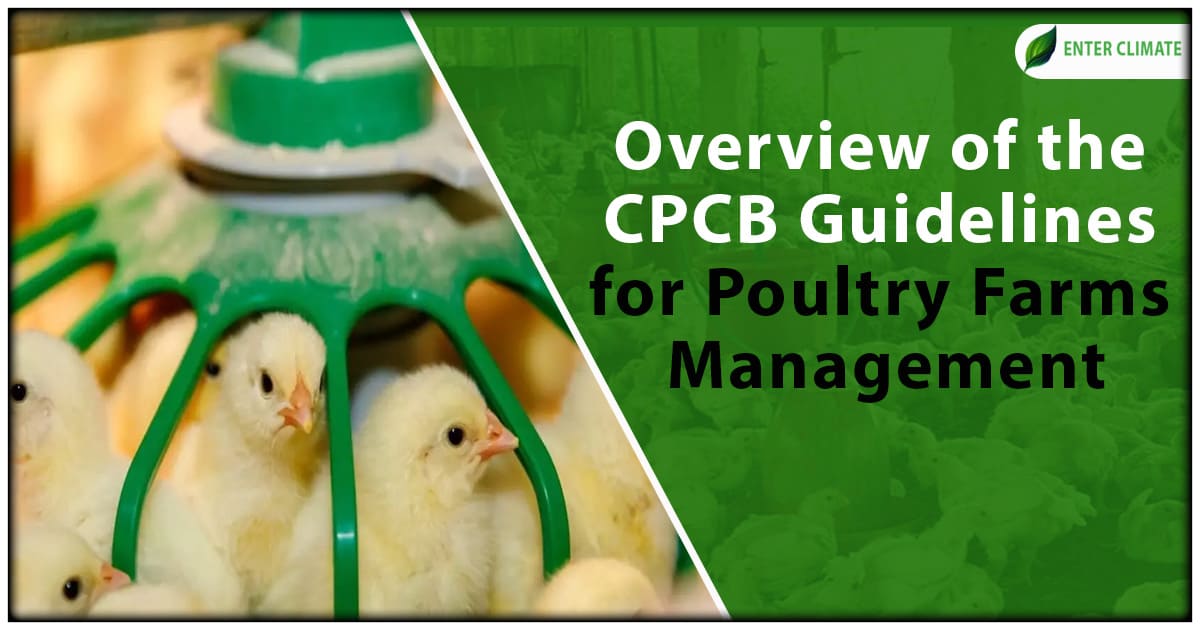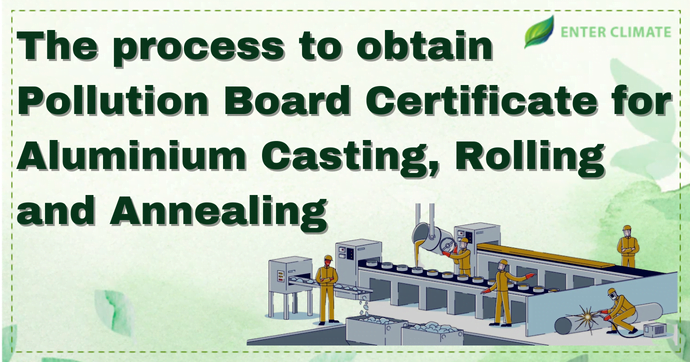Overview of the CPCB Guidelines for Poultry Farms Management
 25 May, 2023
25 May, 2023 
Since the beginning of agriculture, raising domesticated birds (poultry) for their meat, eggs, and feathers has been a key component of supplementing farmers’ income. Today, poultry farming has developed into a highly profitable business that does not require significant investment. Poultry farming is the most rewarding animal husbandry business since it allows for the use of a wide range of feedstock, has demand from both rural and urban markets, does not create significant pollution, and can be done even with limited expertise in the field. Moreover, the feedstock is available as inexpensive grains and by-products from the food processing industry. Eggs and poultry meat are major sources of cheap and quality protein for many. Due to rising demand for affordable meat and egg supplies free from contaminants, poultry farms today have made significant adjustments under the guidelines issued by governmental agencies from time to time. The CPCB Guidelines for Poultry Farms Management, released in 2020, calls for structural changes.
Waste Management Issues in Poultry Farms
As per the National Green Tribunal’s judgement on September 16, 2020, the ” CPCB Guidelines for Poultry Farms Management” were published. By providing certificates of consent to establish (CTE) and consent to operate (CTO), all State Pollution Control Boards were required to put these regulations into effect in their respective states. As per the guidelines, small and medium size poultry farms are categorised under the ‘green’ category, and large size farms are grouped under the ‘orange’ category of industries.
Solid wastes: consist of poultry droppings, manure and litter, dead birds, and hatchery waste like spoilt or unhatched eggs and feathers. Deposited wastes become the sources of harmful gases and pathogenic germs and parasites. Several flies and rodents also breed and create hygiene issues.
Air Emission: The emission of obnoxious gases like ammonia and hydrogen sulphide occurs from the excreta generated by the birds. The odour is produced due to anaerobic conditions in the litter due to its storage in one place for a longer period. If accumulated wastes are not cleaned regularly, then these decompose by bacteria and produce toxins and foul smell gases.
Wastewater and Effluent: Wastewater can accumulate from the overflow of water used for cleaning and leftover water used for drinking by birds. It can be a source of breeding of flies like mosquitoes, houseflies, and other insects.
CPCB Guidelines for Poultry Farms Management
In 2015, CPCB developed the Guidelines for Poultry Farms Management for poultry farms handling 1 lac or more birds. But in 2020, the National Green Tribunal ordered CPCB[1] to review the rules for the enforcement of a proper mechanism for all poultry farms handling more than 5000 birds and ordered that the farms must be subject to the same environmental regulations from January 1, 2023, onwards.
Poultry farms are now categorised based on the number of birds is handles as per CPCB Guidelines for Poultry Farms Management –
CPCB Guidelines for Emission of Gases (NH3 and H2S) and Feed Mill Dust
CPCB Guidelines for Poultry Farm: Minimising Odour or Gaseous Pollution
- To keep the manure dry, airflow should be properly maintained while collecting the manure.
- Dead bird carcasses must be regularly gathered and properly disposed of so as not to affect the environment.
- An appropriate storage facility should be available to collect the manure and litter.
- Manure should not come in contact with runoff water and should avoid pests and insects.
CPCB Guidelines for Poultry Farm: Dust Generated from Feed Mills
- Feed mills and godowns must be built on precisely level terrain, ideally close to the farm’s entrance, and they must be kept separate from the chicken coops.
- The feed mills and the godown’s floors should be made of concrete and raised at least two feet off the ground.
- Dust masks should be worn by or given to workers in the field.
- Systems for dust collection must be placed in the mixing and grinding area to reduce emissions.
- A vehicle tyre dip procedure must be performed at the entrance to clean the dust or contaminants from the vehicle’s tyres.
CPCB Guidelines for Management of Solid Waste (Manure or Litter, Hatchery Debris, and Dead Birds)
Manure Handling and Disposal
- The manure collection must have adequate ventilation and air movement above it in order to keep it dry through air blowing over it or by having suitable ventilation air over the manure pit.
- The poultry housing needs to be adequately aired in order to minimise humidity, stop the growth of gases, and dissipate heat.
- The storage pits used to collect manure need to be shielded from runoff water, covered to keep out dust, and sealed to stop the stench.
- To prevent air emissions and precipitation, the dry manure dump should have a permanent roof over it or be covered with plastic or another similar material.
- Excreta must be removed from deep litter houses at least once every 2 days in order to mix the litter and keep the bedding dry. Furthermore, composting can be done with this material.
- Depending on the quantity and variety of birds, the litter or manure must be placed at least 2 metres above the water table. The base of the litter or manure pit must also be constructed of impermeable compacted clay, stone, or concrete slabs. The dead birds must be collected, stored, transported, and disposed of at a suitable location.
- As per the CPCB Guidelines for Poultry Farms, Solid Waste Management, 2016, must be followed while disposing of domestic hazardous garbage.
- To meet the nutritional requirement of the soil and crops, a proper balance must be maintained while applying manure to the field.
- If manure is gathered beneath cages on high-raised platforms, the following CPCB Guidelines for Poultry Farms must be followed to store and use the manure:
- Composting is a good way for small poultry farms to utilise and get rid of their manure.
- To dispose of and use manure, medium-sized and large poultry farms must produce biogas, compost, or a mix of the two.
- Individual, shared, or a combination of the two should be used by poultry farms in clusters to use and dispose of manure.
CPCB Guidelines for Manure Composting
- Trash must be mixed with carbon-rich materials like paddy straw in the pits. While using a specific process, pure manure can also be composted.
- Depending on the size of the poultry, an institution should develop a composting facility.
- Manure needs to be mixed occasionally to ensure appropriate mixing.
- A moisture content of 35% to 40% is ideal.
- The temperature needs to be examined in order to assess the composting conditions.
- As per the CPCB Guidelines for Poultry Farms, manure collection stations must have adequate ventilation and open airflow to keep them dry.
- Manure and litter should be contained in well-designed storage facilities.
- Compost material needs to be stirred periodically to ensure appropriate mixing.
- The composting facility must be at least 300 metres from the closest house and 100 metres away from any well or watercourse. The ventilation of poultry housing must provide an adequate supply of fresh air to remove humidity, distribute heat, and avoid the buildup of gases like methane, carbon dioxide, and ammonia.
- The storage facilities for litter and dung must be at least 2 m above the water table and large enough for the type and quantity of birds handled. Its foundation should be built using concrete, impermeable clay, or stone slabs.
- Dead poultry resulting from routine farm operations should be quickly removed from live poultry and stored in closed containers before being disposed of within 24 hours.
Regulatory and Monitoring Mechanisms for Poultry Farms
- According to the Water Act of 1974 and the Air Act of 1981, poultry farms with more than 25,000 birds per location must receive the State Pollution Control Board’s (SPCB) or Pollution Control Committee’s (PCC) consent to establish (CTE) and consent to operate (CTO).
- The Animal Husbandry Department of the relevant State or District will assist in executing the poultry farm regulations.
- The “Green Category” poultry farms will receive consent with a 15-year validity.
Government Incentives for Starting a poultry farm
Assistance for Poultry farm setup that is being given by the government includes the following.
Poultry Venture Capital Fund (PVCF): It is being carried out by the Department of Animal Husbandry and Dairy under the National Livestock Mission’s “Entrepreneurship Development and Employment Generation” (EDEG) programme. It is a bankable initiative, and the Central Government offers subsidies to recipients who take out loans for PVCF through the National Bank for Agricultural and Rural Development (NABARD).
National Livestock Mission: Various initiatives under the National Livestock Mission offer financial support to States and UTs for the implementation of the Innovative Poultry Productivity Project (IPPP) and the Rural Backyard Poultry Development (RBPD).
Assistance to States for Control of Animal Diseases (ASCAD) Scheme: ASCAD’s “Livestock Health and Disease Control” (LH&DC) programme, which includes the management and containment of emerging and exotic diseases like Avian Influenza and the immunisation against economically significant poultry diseases including Ranikhet Disease, Infectious Bursal Disease, and Fowl Pox.
Licences and Documents Required for Starting a Poultry Farms
- Company’s incorporation certificate
- MSME Registration
- Pollution NOC from SPCB
- NOC from the local village Panchayat.
- CGWA NOC (for the abstraction of groundwater)
- Identity Proof: PAN and Aadhaar card
- Fire NOC
- land documents
- Business Licenses & permits, as per the state laws
Market Opportunity in Poultry Farming
The poultry industry in India is huge, and Poultry farming has developed into a thriving agribusiness. It has continually engaged in operations like breeding, hatching, broiling, and any other activity it may entail. India is ranked third in egg production and fifth in broiler meat production, with 75 billion and 4.20 million tons, respectively. India’s poultry industry contributes 5% and 2.5 % of the total global output in meat and eggs. Indian poultry market reached a value of 28.18 billion USD in 2022 and is expected to grow at a CAGR of 8.1% from 2023-2028 to reach a value of 44.97 billion USD by 2028.
Conclusion
CPCB Guidelines for Poultry Farms Management have provided extensive detail on the proper management of Poultry farms to ensure a sustainable environment. Along with the management guidelines, the government have also put in place various initiatives to encourage business owners and provide a better marketplace. Therefore, an entrepreneur should take advantage of government incentives to enter into this highly rewarding business. This will require fulfilling all legal obligations in starting a farm that could be done swiftly and hassle-free with the assistance of licencing and compliance experts.
Read our Article:CPCB Guidelines For Financial Support For Establishing Pelletisation And Torrefaction Plants













